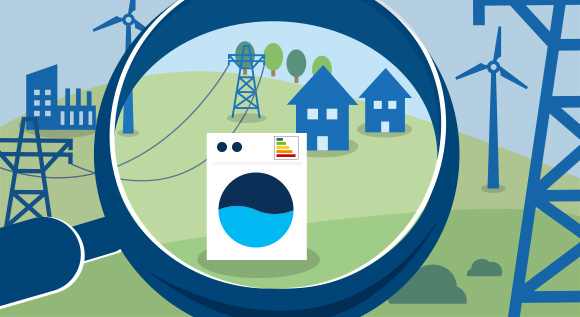The EU Energy Label –or what you’ve always wanted to know about your household appliances
How much electricity does a new appliance need? What else can the energy label tell me? The label guide has all the answers. Please read on to learn more.
 © BMWi
© BMWi
The EU energy label provides important information about the appliance’s electricity consumption and other characteristics that can help you make your purchasing decision.
There is a good chance that the EU Energy Label can help you tell in advance whether you will be happy with a certain new household appliance. A growing number of people check out the label to find out about the device’s energy efficiency category. Green stands for high efficiency, red for low efficiency. But what is all the information in the lower half of the label about?
Energy efficiency and beyond
If you look at the label of a dishwasher, you will find that the first piece of information given below the colour-coded bar is the appliance’s electricity consumption in kilowatt hours (kWh) for 280 cycles per year. An appliance in the A+++ efficiency category uses 230 kWh, compared to 290 kWh for an appliance classed in the A+ category. This difference of 60 kWh translates into savings of roughly €17 per year.
The tap icon located on the left-hand side below the information on electricity consumption shows how much water is used by the appliance for 280 cycles per year. Less than 10 litres per cycle counts as a good performance. For 280 cycles a year, this means up to 2,800 litres. If the device needs 12 litres per cycle, this adds up to an annual water consumption of 3,300 litres, or 500 litres more, costing an additional €2 per year.
The symbol located to the right-hand side of this information, representing a steaming plate, indicates how good the device’s drying ability is. This performance is rated from A to G or best to worst. All of the standard dishwashers available fall into category A. It is only smaller (tabletop) devices that are sometimes classed as category B. Categories C to G are not used in practice.
The icon representing dishes allows consumers to see whether the device has the right capacity for their household. It shows how many covers (each consisting of a plate, soup plate, dessert bowl, cup, saucer, a glass, and five pieces of cutlery) fit into the dishwasher. A device that is 60 centimetres wide can usually hold up to 14 standard covers, which is ideal for mid-sized households of three to four people. A typical 45 centimetre appliance can only be used for up to 10 covers at a time. It may well make sense for small households or single people to opt for a 60 centimetre device, as these are often more efficient when it comes to power and water consumption.
The loudspeaker symbol located at the far right side of the label indicates the level of noise generated by the appliance (in decibel or dB). Devices are considered to be quiet if they generate a maximum of 40 dB, which is about the same as a fan. 30 dB is the amount of noise caused by whispering. Noises of 80 dB or more are perceived to be loud.
The label guide is part of the National Top Runners initiative
As you can see, it makes good sense to look at the small print of the energy label – and not only of those attached to dishwashers. The Federal Ministry for Economic Affairs and Energy has developed a label guide as part of its national Top Runners initiative. The guide is designed to support consumers in their quest for energy efficient appliances. It is available for: washing machines, tumble dryers, refrigerators, dishwashers, TV sets and LED lamps. Step by step, the label guide navigates consumers towards the energy efficient appliances that best suit them, thus helping to save a great deal of money in energy costs. An average household can save up to €100 in electricity costs per year, simply by using a tumble dryer classed as A+++, compared to a class B device.

